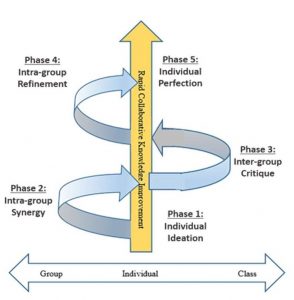Technology integration during collaborative argumentation
NIE Associate Professor Chen Wenli shares about her current research study on the design and use of a digital system for collaborative argumentation in classrooms and the benefits it brings about.

Value-Add Learning with Technology
There is no denying that technology introduces a wide variety of tools that can help stimulate real-time and authentic student-teacher and student-student interactions. However, for technology to effect teaching and learning positively, it has to be purposefully and carefully incorporated.
“Traditional methods work, but meaningful integration of technology can make teaching and learning better,” Wenli, who is also Head of the Learning Sciences and Assessment Academic Group at NIE, shares. When mindfully and purposefully integrated, the use of technology can increase students’ learning motivation and open up more room for learning opportunities for them.
She also adds that the Technological Pedagogical Content Knowledge (TPACK) framework (Mishra & Koehler, 2006) guides teachers on the integration of technology to design meaningful learning environments and experiences for students. “The framework attempts to identify the nature of knowledge required by teachers for technology integration in their teaching while addressing the complex, multifaceted and situated nature of teacher knowledge.”
For Wenli’s research project, she and her team collaborate with a number of primary and secondary schools in Singapore to support the enactment of collaborative argumentation in Science, English, Social Studies and History, and project works with the integration of a digital system.
So what is collaborative argumentation and how can technology support it?
Technology-Supported Collaborative Argumentation
From a constructivist perspective, interaction plays a vital role in an individual’s learning because it is through that that one has his or her thinking and perspectives challenged.
“Generating and assessing arguments is essential in these inquiry and authentic learning experiences. Developing students’ argumentation skills is an important component of developing students’ 21st century competencies, in particular, critical and reflective thinking,” Wenli explains.
This approach typically begins with questions and requires students to analyse, interpret and evaluate a range of evidence and information sources to develop their conclusions and make claims, as opposed to taking claims as given. “These are crucial steps to developing sound argumentation skills. Much effective argumentation happens between multiple participants who engage in evaluation, reflection, reasoning and decision making through arguments and counterarguments in relation to a specific topic,” she adds.
However, Wenli notes that effective collaborative argumentation rarely occurs in classrooms because one of the critical issues contributing to that is the lack of technological and pedagogical support in designing, implementing, evaluating and reflecting on the argumentation for both teachers and students.
“According to existing literature, individual students in a group do not automatically collaborate and argue as a group,” she explains. “Scaffolds need to be provided to bring the group work into fruition.” This is where technology can aid effective collaborative argumentation.
"Developing students’ argumentation skills is an important component of developing students’ 21st century competencies, in particular, critical and reflective thinking."
Embracing Technology in Classrooms with AppleTree
A large part of Wenli’s research project involves conceptualizing, designing and eventually integrating a digital system to support students’ collaborative argumentation in classrooms.
“We developed a system called AppleTree, which incorporates mechanisms for scripting collaborative argumentation and supporting real-time formative (diagnostic) learning analytics and assessment that enhance the process and outcome of collaborative argumentation to improve students’ learning and cultivate their 21st century competencies,” she shares.
AppleTree embeds a pedagogical model called Spiral Model of Collaborative Knowledge Improvement which provides the support necessary for a smooth transition between work in solitude and collaborative learning within a classroom setting.
“AppleTree provides real-time learning analytics and assessment of students’ collaborative argumentation. The real-time assessment allows teachers and students to have a quick evaluation and reflection of their collaborative argumentation process and outcome from the aspects of social participation, collaboration and cognitive quality.”
Wenli notes that as of today, there are more than 300 students who have used AppleTree for collaborative argumentation in Science, English, Social Studies and project works. Her research findings have also shown that the use of this digital system not only helps students develop a deeper understanding of content knowledge, but also their 21st century competencies, in particular, communication and collaboration, and creative and inventive thinking.

According to education researchers Chen, Tan and Pi (2021), The Spiral Model of Collaborative Knowledge Improvement (SMCKI) is a 5-phase pedagogical model that was developed to strengthen the connection between the individual and group.
It starts with a phase of individual ideation, the model leads to phases of intra-group and inter-group knowledge improvement and refinement through peer critique, which will lead to the advancement of the knowledge of students.
A Blend of Technology and Traditional Practices
Education is no longer just pen and paper, and memorizing of facts. Today, educators far and wide are improving their teaching practices through the use of technology. The current pandemic has further fuelled the rapid adoption of technology-assisted pedagogies and blended learning models.
Wenli advises teachers who may wish to start incorporating technologies into their daily classroom practices, “When designing a technology-integrated lesson, teachers can first choose the learning outcomes (content) of that class session. The learning outcomes are the content. The second step is to decide how the students are going to learn the content (pedagogy). Finally, teachers can choose technologies that will support the pedagogy and aid the students in learning the content.”
However, some teachers may still find it a struggle to adapt to these changing teaching and learning landscapes. After all, teaching practices are in fact the key to effective instruction and matter more than the presence or absence of specific tools.
At the end of the day, for Wenli, she feels that if the traditional pen-and-paper approach can achieve the same level of learning outcomes, the use of technology may not always be necessary. “When integrating technology in teaching and learning, teachers need to be clear about the value-added part of the technology,” she concludes.
References
Chen, W., Tan, J. S. H., & Pi, Z. (2021). The spiral model of collaborative knowledge improvement: an exploratory study of a networked collaborative classroom. International Journal of Computer-Supported Collaborative Learning, 16,
7–35.
Mishra, P., & Koehler, M. J. (2006). Technological pedagogical content knowledge: A framework for teacher knowledge. Teachers College Record, 108(6), 1017–1054.
This story was first published in Singteach, an e-magazine published by the Office of Education Research at the National Institute of Education, Singapore, an institute of NTU Singapore.


.tmb-listing.jpg?Culture=en&sfvrsn=ab6472c8_1)
.tmb-listing.jpg?Culture=en&sfvrsn=332749b0_1)

.tmb-listing.jpg?Culture=en&sfvrsn=c712bd4c_1)

